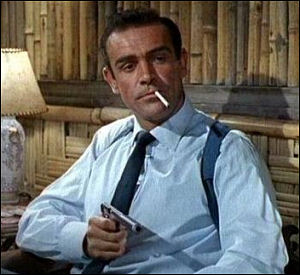My favorite James Bond moment of all time was about cold-blooded murder. It happened in Dr. No when Sean Connery looked at Anthony Dawson‘s Professor Dent, told him that the weapon he’s just tried to dispatch Connery with “is a Smith and Wesson, and you’ve had your six.” And then thunk! And then once more for good measure, in Dawson’s back….thunk! Cold as ice, and rather enjoying it.

This is the 007 I’ve wanted to hang with with ever since, but who’s never once re-appeared. Not really. Except, I suppose, mildly speaking, in the finale of Casino Royale. A guy who has a license to be an heartless killing bastard and get away with it.
This is in response to Matthew Oshinsky‘s 11.3 Daily Beast piece, “Has Bond Lost His Balls?”
“The new Bond is unmistakably a hero of the 21st century, when his baggage sells tickets. Some have compared him with Jason Bourne, the amnesiac contract assassin who made Matt Damon a household name. Like Bond, Bourne kills his way to the truth. But the better parallel is found in the rejuvenated Batman series, which has stripped its central character of his outdated penthouse charm (a la Adam West and Michael Keaton, neither of whom appeared out of uniform without arm candy), and focused morbid attention on his self-esteem.
These are dark and lonely times for our action stars. Much like Bruce Wayne, James Bond is accustomed to having a lot more sex.
“When the first Bond film, Dr. No, was released in 1962, the superagent’s masculinity was measured as much by his domination of women as by pistol skills. Nearly 50 years later, it is measured by the cuts on his face and the scars in his soul. Of course, the character is more difficult to pin down now — thanks to the rejiggering of the series’ chronology, he is at once younger than he was in Dr. No, yet fighting eco-terrorists in 2008. In Quantum of Solace, Bond is still inexperienced, unaware of himself, and about as romantic as a rottweiler. Maybe he just needs time to blossom into the man who seduced the globe in the seamy ’60s.
“Or is this dispassionate killer the one Fleming first envisioned? The author, a notorious womanizer who had served in the Naval Intelligence Division of the Admiralty, once called his creation a ‘highly romanticized version of a true spy.’ But most agree that Fleming based Bond on himself, infusing the character with both the cold ferocity and the magnetism that he did not fully possess.
“Initially, studios rejected the idea of adapting Bond for the screen not on account of his immodest sexuality, not is bloodlust. But the immediate success of Dr. No with male and female viewers alike showed that belly dancers and unsheathed innuendos would be essential elements in any tale of espionage told in the 1960s. After Fleming died in 1964, the cold war thawed, the counterculture evolved, and Bond’s libido became his defining characteristic. But by the 1990s, Brosnan smirked his way into sexual parody and invisible missile-loaded cars received top billing.
“The version of Bond that Hollywood has offered over the span of 22 movies has always been decided by the prevailing desires of the era. This Bond is joining us in an uncertain time — heartbroken, confused, vengeful, and chugging his martinis rather than just sipping them.”









